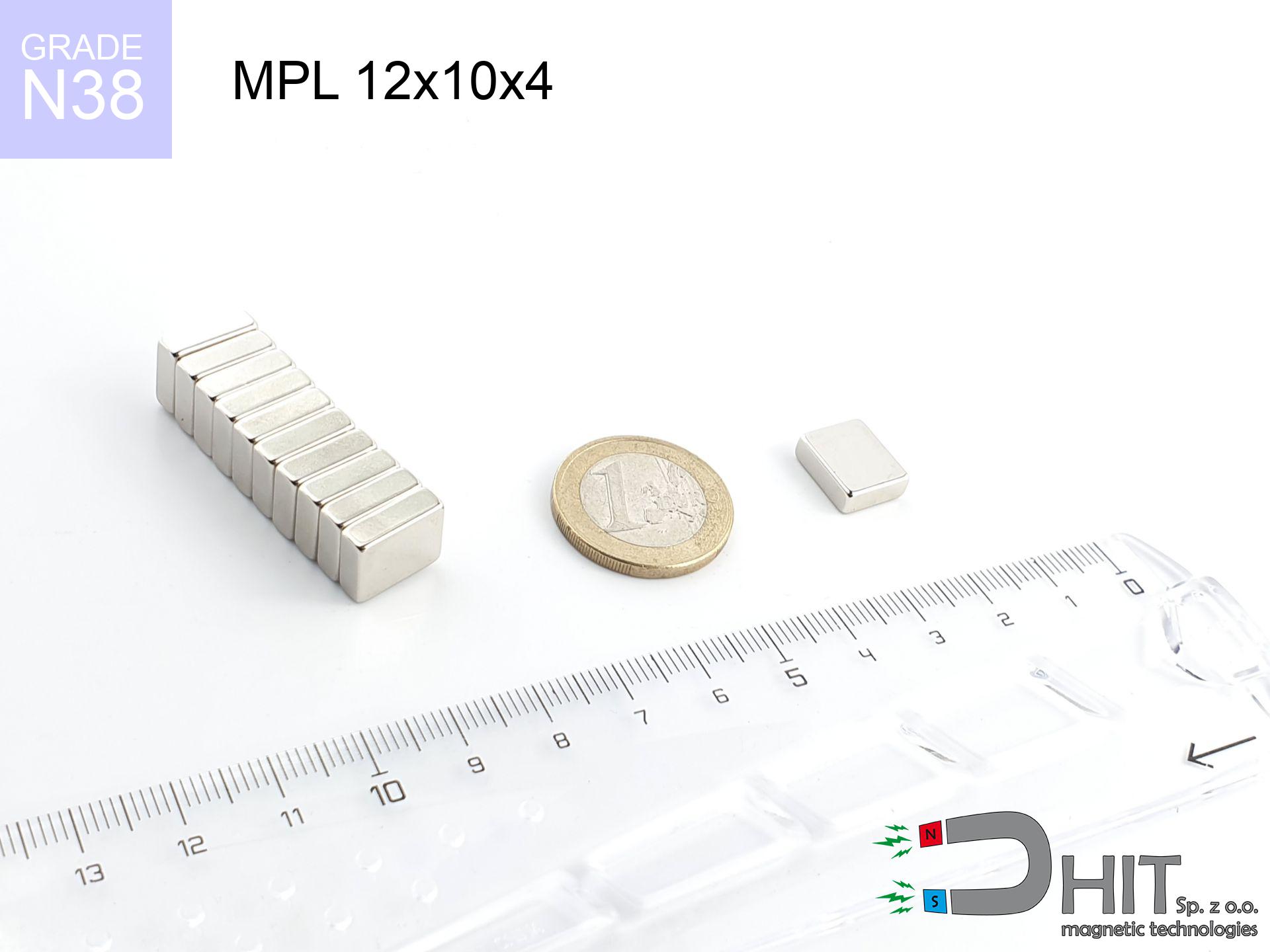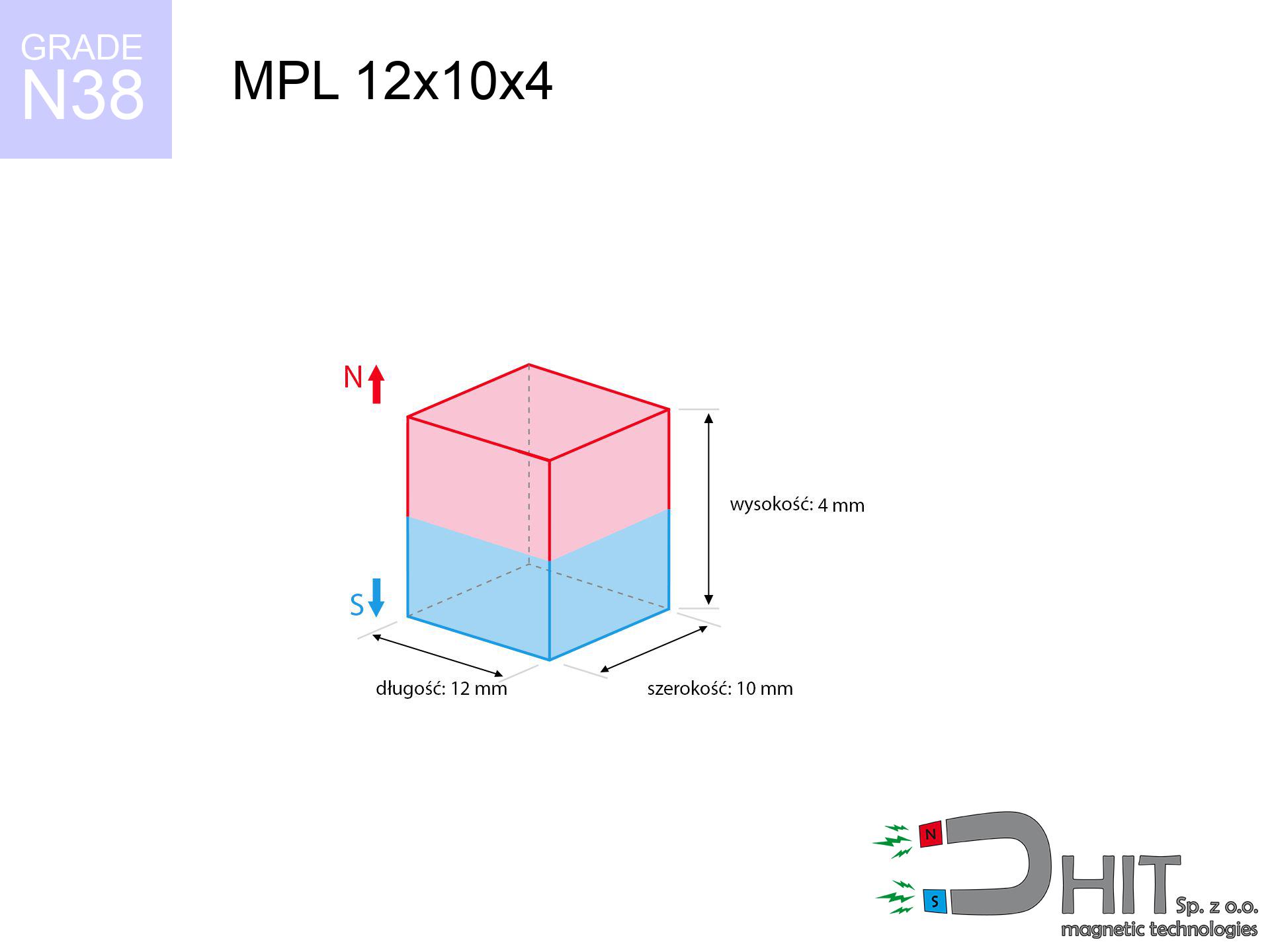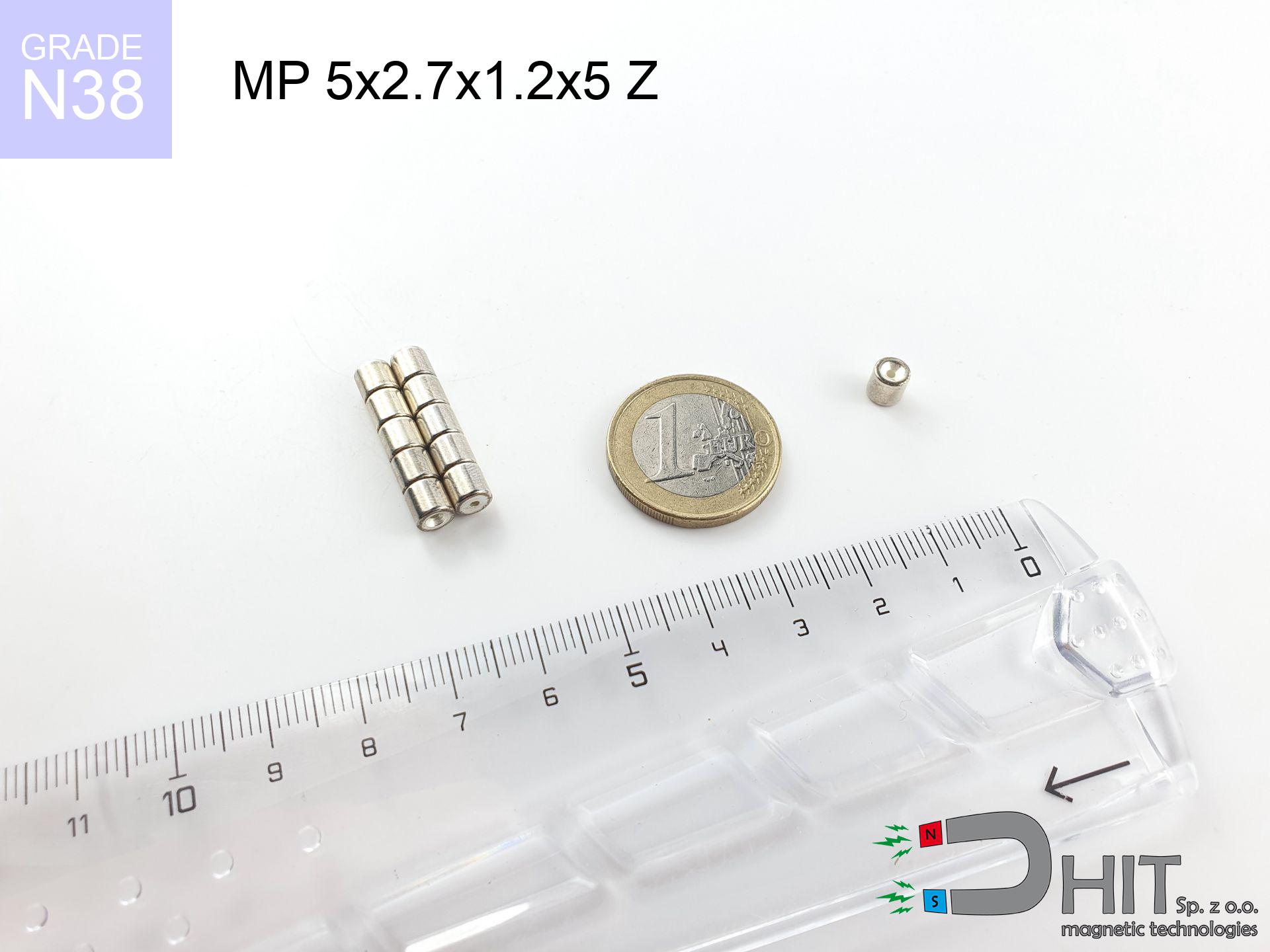MPL 12x10x4 / N38 - lamellar magnet
lamellar magnet
Catalog no 020118
GTIN/EAN: 5906301811244
length
12 mm [±0,1 mm]
Width
10 mm [±0,1 mm]
Height
4 mm [±0,1 mm]
Weight
3.6 g
Magnetization Direction
↑ axial
Load capacity
3.45 kg / 33.88 N
Magnetic Induction
340.59 mT / 3406 Gs
Coating
[NiCuNi] Nickel
1.697 ZŁ with VAT / pcs + price for transport
1.380 ZŁ net + 23% VAT / pcs
bulk discounts:
Need more?Looking for a better price?
Give us a call
+48 22 499 98 98
or get in touch by means of
our online form
the contact page.
Weight along with shape of magnetic components can be analyzed using our
magnetic calculator.
Same-day processing for orders placed before 14:00.
MPL 12x10x4 / N38 - lamellar magnet
Specification / characteristics MPL 12x10x4 / N38 - lamellar magnet
| properties | values |
|---|---|
| Cat. no. | 020118 |
| GTIN/EAN | 5906301811244 |
| Production/Distribution | Dhit sp. z o.o. |
| Country of origin | Poland / China / Germany |
| Customs code | 85059029 |
| length | 12 mm [±0,1 mm] |
| Width | 10 mm [±0,1 mm] |
| Height | 4 mm [±0,1 mm] |
| Weight | 3.6 g |
| Magnetization Direction | ↑ axial |
| Load capacity ~ ? | 3.45 kg / 33.88 N |
| Magnetic Induction ~ ? | 340.59 mT / 3406 Gs |
| Coating | [NiCuNi] Nickel |
| Manufacturing Tolerance | ±0.1 mm |
Magnetic properties of material N38
| properties | values | units |
|---|---|---|
| remenance Br [min. - max.] ? | 12.2-12.6 | kGs |
| remenance Br [min. - max.] ? | 1220-1260 | mT |
| coercivity bHc ? | 10.8-11.5 | kOe |
| coercivity bHc ? | 860-915 | kA/m |
| actual internal force iHc | ≥ 12 | kOe |
| actual internal force iHc | ≥ 955 | kA/m |
| energy density [min. - max.] ? | 36-38 | BH max MGOe |
| energy density [min. - max.] ? | 287-303 | BH max KJ/m |
| max. temperature ? | ≤ 80 | °C |
Physical properties of sintered neodymium magnets Nd2Fe14B at 20°C
| properties | values | units |
|---|---|---|
| Vickers hardness | ≥550 | Hv |
| Density | ≥7.4 | g/cm3 |
| Curie Temperature TC | 312 - 380 | °C |
| Curie Temperature TF | 593 - 716 | °F |
| Specific resistance | 150 | μΩ⋅cm |
| Bending strength | 250 | MPa |
| Compressive strength | 1000~1100 | MPa |
| Thermal expansion parallel (∥) to orientation (M) | (3-4) x 10-6 | °C-1 |
| Thermal expansion perpendicular (⊥) to orientation (M) | -(1-3) x 10-6 | °C-1 |
| Young's modulus | 1.7 x 104 | kg/mm² |
Technical modeling of the product - report
These values are the outcome of a physical calculation. Results are based on algorithms for the class Nd2Fe14B. Real-world performance may differ. Treat these data as a supplementary guide when designing systems.
MPL 12x10x4 / N38
| Distance (mm) | Induction (Gauss) / mT | Pull Force (kg) | Risk Status |
|---|---|---|---|
| 0 mm |
3404 Gs
340.4 mT
|
3.45 kg / 3450.0 g
33.8 N
|
warning |
| 1 mm |
2920 Gs
292.0 mT
|
2.54 kg / 2538.8 g
24.9 N
|
warning |
| 2 mm |
2399 Gs
239.9 mT
|
1.71 kg / 1713.7 g
16.8 N
|
weak grip |
| 3 mm |
1919 Gs
191.9 mT
|
1.10 kg / 1096.3 g
10.8 N
|
weak grip |
| 5 mm |
1190 Gs
119.0 mT
|
0.42 kg / 421.6 g
4.1 N
|
weak grip |
| 10 mm |
392 Gs
39.2 mT
|
0.05 kg / 45.7 g
0.4 N
|
weak grip |
| 15 mm |
162 Gs
16.2 mT
|
0.01 kg / 7.8 g
0.1 N
|
weak grip |
| 20 mm |
80 Gs
8.0 mT
|
0.00 kg / 1.9 g
0.0 N
|
weak grip |
| 30 mm |
27 Gs
2.7 mT
|
0.00 kg / 0.2 g
0.0 N
|
weak grip |
| 50 mm |
7 Gs
0.7 mT
|
0.00 kg / 0.0 g
0.0 N
|
weak grip |
MPL 12x10x4 / N38
| Distance (mm) | Friction coefficient | Pull Force (kg) |
|---|---|---|
| 0 mm | Stal (~0.2) |
0.69 kg / 690.0 g
6.8 N
|
| 1 mm | Stal (~0.2) |
0.51 kg / 508.0 g
5.0 N
|
| 2 mm | Stal (~0.2) |
0.34 kg / 342.0 g
3.4 N
|
| 3 mm | Stal (~0.2) |
0.22 kg / 220.0 g
2.2 N
|
| 5 mm | Stal (~0.2) |
0.08 kg / 84.0 g
0.8 N
|
| 10 mm | Stal (~0.2) |
0.01 kg / 10.0 g
0.1 N
|
| 15 mm | Stal (~0.2) |
0.00 kg / 2.0 g
0.0 N
|
| 20 mm | Stal (~0.2) |
0.00 kg / 0.0 g
0.0 N
|
| 30 mm | Stal (~0.2) |
0.00 kg / 0.0 g
0.0 N
|
| 50 mm | Stal (~0.2) |
0.00 kg / 0.0 g
0.0 N
|
MPL 12x10x4 / N38
| Surface type | Friction coefficient / % Mocy | Max load (kg) |
|---|---|---|
| Raw steel |
µ = 0.3
30% Nominalnej Siły
|
1.04 kg / 1035.0 g
10.2 N
|
| Painted steel (standard) |
µ = 0.2
20% Nominalnej Siły
|
0.69 kg / 690.0 g
6.8 N
|
| Oily/slippery steel |
µ = 0.1
10% Nominalnej Siły
|
0.35 kg / 345.0 g
3.4 N
|
| Magnet with anti-slip rubber |
µ = 0.5
50% Nominalnej Siły
|
1.73 kg / 1725.0 g
16.9 N
|
MPL 12x10x4 / N38
| Steel thickness (mm) | % power | Real pull force (kg) |
|---|---|---|
| 0.5 mm |
|
0.35 kg / 345.0 g
3.4 N
|
| 1 mm |
|
0.86 kg / 862.5 g
8.5 N
|
| 2 mm |
|
1.73 kg / 1725.0 g
16.9 N
|
| 5 mm |
|
3.45 kg / 3450.0 g
33.8 N
|
| 10 mm |
|
3.45 kg / 3450.0 g
33.8 N
|
MPL 12x10x4 / N38
| Ambient temp. (°C) | Power loss | Remaining pull | Status |
|---|---|---|---|
| 20 °C | 0.0% |
3.45 kg / 3450.0 g
33.8 N
|
OK |
| 40 °C | -2.2% |
3.37 kg / 3374.1 g
33.1 N
|
OK |
| 60 °C | -4.4% |
3.30 kg / 3298.2 g
32.4 N
|
|
| 80 °C | -6.6% |
3.22 kg / 3222.3 g
31.6 N
|
|
| 100 °C | -28.8% |
2.46 kg / 2456.4 g
24.1 N
|
MPL 12x10x4 / N38
| Gap (mm) | Attraction (kg) (N-S) | Repulsion (kg) (N-N) |
|---|---|---|
| 0 mm |
8.57 kg / 8573 g
84.1 N
4 915 Gs
|
N/A |
| 1 mm |
7.46 kg / 7455 g
73.1 N
6 349 Gs
|
6.71 kg / 6710 g
65.8 N
~0 Gs
|
| 2 mm |
6.31 kg / 6309 g
61.9 N
5 841 Gs
|
5.68 kg / 5678 g
55.7 N
~0 Gs
|
| 3 mm |
5.23 kg / 5228 g
51.3 N
5 317 Gs
|
4.71 kg / 4705 g
46.2 N
~0 Gs
|
| 5 mm |
3.42 kg / 3423 g
33.6 N
4 302 Gs
|
3.08 kg / 3081 g
30.2 N
~0 Gs
|
| 10 mm |
1.05 kg / 1048 g
10.3 N
2 380 Gs
|
0.94 kg / 943 g
9.3 N
~0 Gs
|
| 20 mm |
0.11 kg / 114 g
1.1 N
784 Gs
|
0.10 kg / 102 g
1.0 N
~0 Gs
|
| 50 mm |
0.00 kg / 1 g
0.0 N
90 Gs
|
0.00 kg / 0 g
0.0 N
~0 Gs
|
MPL 12x10x4 / N38
| Object / Device | Limit (Gauss) / mT | Safe distance |
|---|---|---|
| Pacemaker | 5 Gs (0.5 mT) | 6.0 cm |
| Hearing aid | 10 Gs (1.0 mT) | 4.5 cm |
| Timepiece | 20 Gs (2.0 mT) | 3.5 cm |
| Phone / Smartphone | 40 Gs (4.0 mT) | 3.0 cm |
| Car key | 50 Gs (5.0 mT) | 2.5 cm |
| Payment card | 400 Gs (40.0 mT) | 1.0 cm |
| HDD hard drive | 600 Gs (60.0 mT) | 1.0 cm |
MPL 12x10x4 / N38
| Start from (mm) | Speed (km/h) | Energy (J) | Predicted outcome |
|---|---|---|---|
| 10 mm |
31.48 km/h
(8.74 m/s)
|
0.14 J | |
| 30 mm |
54.08 km/h
(15.02 m/s)
|
0.41 J | |
| 50 mm |
69.81 km/h
(19.39 m/s)
|
0.68 J | |
| 100 mm |
98.73 km/h
(27.42 m/s)
|
1.35 J |
MPL 12x10x4 / N38
| Technical parameter | Value / Description |
|---|---|
| Coating type | [NiCuNi] Nickel |
| Layer structure | Nickel - Copper - Nickel |
| Layer thickness | 10-20 µm |
| Salt spray test (SST) ? | 24 h |
| Recommended environment | Indoors only (dry) |
MPL 12x10x4 / N38
| Parameter | Value | SI Unit / Description |
|---|---|---|
| Magnetic Flux | 4 295 Mx | 42.9 µWb |
| Pc Coefficient | 0.43 | Low (Flat) |
MPL 12x10x4 / N38
| Environment | Effective steel pull | Effect |
|---|---|---|
| Air (land) | 3.45 kg | Standard |
| Water (riverbed) |
3.95 kg
(+0.50 kg Buoyancy gain)
|
+14.5% |
1. Vertical hold
*Caution: On a vertical wall, the magnet holds just ~20% of its perpendicular strength.
2. Efficiency vs thickness
*Thin metal sheet (e.g. computer case) severely limits the holding force.
3. Temperature resistance
*For standard magnets, the critical limit is 80°C.
4. Demagnetization curve and operating point (B-H)
chart generated for the permeance coefficient Pc (Permeance Coefficient) = 0.43
The chart above illustrates the magnetic characteristics of the material within the second quadrant of the hysteresis loop. The solid red line represents the demagnetization curve (material potential), while the dashed blue line is the load line based on the magnet's geometry. The Pc (Permeance Coefficient), also known as the load line slope, is a dimensionless value that describes the relationship between the magnet's shape and its magnetic stability. The intersection of these two lines (the black dot) is the operating point — it determines the actual magnetic flux density generated by the magnet in this specific configuration. A higher Pc value means the magnet is more 'slender' (tall relative to its area), resulting in a higher operating point and better resistance to irreversible demagnetization caused by external fields or temperature. A value of 0.42 is relatively low (typical for flat magnets), meaning the operating point is closer to the 'knee' of the curve — caution is advised when operating at temperatures near the maximum limit to avoid strength loss.
Material specification
| iron (Fe) | 64% – 68% |
| neodymium (Nd) | 29% – 32% |
| boron (B) | 1.1% – 1.2% |
| dysprosium (Dy) | 0.5% – 2.0% |
| coating (Ni-Cu-Ni) | < 0.05% |
Sustainability
| recyclability (EoL) | 100% |
| recycled raw materials | ~10% (pre-cons) |
| carbon footprint | low / zredukowany |
| waste code (EWC) | 16 02 16 |
Other proposals
Advantages and disadvantages of Nd2Fe14B magnets.
Advantages
- They retain full power for nearly ten years – the drop is just ~1% (based on simulations),
- Neodymium magnets are remarkably resistant to magnetic field loss caused by external magnetic fields,
- Thanks to the smooth finish, the surface of Ni-Cu-Ni, gold-plated, or silver-plated gives an modern appearance,
- Magnetic induction on the working layer of the magnet turns out to be maximum,
- Neodymium magnets are characterized by extremely high magnetic induction on the magnet surface and are able to act (depending on the shape) even at a temperature of 230°C or more...
- Due to the ability of flexible shaping and customization to individualized requirements, magnetic components can be modeled in a wide range of geometric configurations, which amplifies use scope,
- Universal use in modern industrial fields – they serve a role in hard drives, drive modules, precision medical tools, and multitasking production systems.
- Thanks to their power density, small magnets offer high operating force, occupying minimum space,
Limitations
- They are fragile upon too strong impacts. To avoid cracks, it is worth protecting magnets using a steel holder. Such protection not only protects the magnet but also improves its resistance to damage
- We warn that neodymium magnets can reduce their power at high temperatures. To prevent this, we advise our specialized [AH] magnets, which work effectively even at 230°C.
- They oxidize in a humid environment - during use outdoors we recommend using waterproof magnets e.g. in rubber, plastic
- Limited possibility of creating threads in the magnet and complex forms - preferred is casing - magnetic holder.
- Potential hazard related to microscopic parts of magnets can be dangerous, in case of ingestion, which becomes key in the aspect of protecting the youngest. Furthermore, small elements of these magnets are able to disrupt the diagnostic process medical after entering the body.
- Higher cost of purchase is one of the disadvantages compared to ceramic magnets, especially in budget applications
Holding force characteristics
Highest magnetic holding force – what affects it?
- with the application of a sheet made of low-carbon steel, ensuring maximum field concentration
- with a thickness of at least 10 mm
- with a surface perfectly flat
- without any air gap between the magnet and steel
- under perpendicular force direction (90-degree angle)
- at temperature approx. 20 degrees Celsius
Lifting capacity in practice – influencing factors
- Distance (betwixt the magnet and the plate), because even a tiny clearance (e.g. 0.5 mm) leads to a decrease in force by up to 50% (this also applies to paint, corrosion or dirt).
- Loading method – declared lifting capacity refers to pulling vertically. When slipping, the magnet holds significantly lower power (often approx. 20-30% of maximum force).
- Element thickness – to utilize 100% power, the steel must be sufficiently thick. Thin sheet limits the attraction force (the magnet "punches through" it).
- Steel type – low-carbon steel gives the best results. Higher carbon content lower magnetic permeability and holding force.
- Smoothness – ideal contact is possible only on polished steel. Rough texture reduce the real contact area, reducing force.
- Thermal conditions – neodymium magnets have a negative temperature coefficient. At higher temperatures they are weaker, and in frost they can be stronger (up to a certain limit).
Holding force was tested on the plate surface of 20 mm thickness, when the force acted perpendicularly, whereas under attempts to slide the magnet the holding force is lower. Moreover, even a minimal clearance between the magnet’s surface and the plate reduces the load capacity.
Fire warning
Powder generated during machining of magnets is combustible. Avoid drilling into magnets unless you are an expert.
Danger to the youngest
NdFeB magnets are not intended for children. Swallowing multiple magnets may result in them connecting inside the digestive tract, which constitutes a critical condition and necessitates urgent medical intervention.
Permanent damage
Watch the temperature. Heating the magnet above 80 degrees Celsius will destroy its magnetic structure and strength.
Hand protection
Watch your fingers. Two large magnets will snap together instantly with a force of several hundred kilograms, destroying anything in their path. Be careful!
Fragile material
NdFeB magnets are ceramic materials, which means they are very brittle. Clashing of two magnets leads to them breaking into shards.
Keep away from computers
Device Safety: Strong magnets can damage data carriers and sensitive devices (heart implants, medical aids, mechanical watches).
Medical interference
Patients with a ICD must keep an absolute distance from magnets. The magnetism can interfere with the functioning of the life-saving device.
Magnetic interference
Remember: neodymium magnets generate a field that disrupts sensitive sensors. Keep a separation from your phone, device, and navigation systems.
Metal Allergy
Studies show that the nickel plating (standard magnet coating) is a potent allergen. If you have an allergy, prevent direct skin contact and opt for encased magnets.
Immense force
Use magnets consciously. Their immense force can surprise even experienced users. Plan your moves and respect their force.






![UMGGZ 34x6 [M4] GZ / N38 - rubber magnetic holder external thread UMGGZ 34x6 [M4] GZ / N38 - rubber magnetic holder external thread](https://cdn3.dhit.pl/graphics/products/umg-34x6-m4-gz-rad.jpg)

![UMGW 75x33x18 [M10] GW / N38 - magnetic holder internal thread UMGW 75x33x18 [M10] GW / N38 - magnetic holder internal thread](https://cdn3.dhit.pl/graphics/products/umgw-75x33x18-m10-gw-cak.jpg)

